SSZT110 december 2021 AM6442
If you're a designer working on a new product that will use an Arm®-based processor, you're probably already comfortable working with integrated circuits (ICs) that have four to 48 pins. You may occasionally use a device with more pins, even though it takes a considerable amount of time to read the data sheet and make sure that everything is wired up correctly.
But even after getting yourself up to speed, it can be overwhelming to think about designing a board with processors, double-data-rate (DDR) memory, embedded multimedia cards (eMMC), complex physical layout, and Wi-Fi® plus Bluetooth®, along with the layer count of your printed circuit board (PCB), length-matched and impedance-controlled traces, electromagnetic interference and electromagnetic compatibility (EMI/EMC), and the power distribution network.
If you don't have the experience required to design a chip-down PCB using a processor, don't have enough time in your development cycle to start from scratch, or need a protocol-compliant system to integrate, consider a system-on-module (SoM).
SoMs are small, allowing them to fit into tight spaces such as enclosures required by home automation applications. SoMs are also resilient, making them appropriate for the harsher conditions of building and industrial automation. Using an SoM can help reduce time to market, cost and design risk. Within TI's third-party ecosystem, there are vendors who design and manufacturer SoMs based on TI processors and offer custom carrier board design services, free technical support and a commitment to long-term product availability.
In order to fully understand SoMs and their benefits, let's first define some of the terminology:
- A SoM is a PCB that functions as a complete embedded computer system, comprising a processor (or multiprocessor unit) and all of the ICs required for the processor to function properly, including read-only memory, random access memory, power-management ICs, crystal oscillators and passive components. High-density interconnects between the module and carrier board build an application-agnostic embedded computing platform, and the definition of the interconnect pins may be proprietary or standardized. Although not technically accurate, the word "SoM" is sometimes used to describe the collective industry of embedded computing PCBs. Figure 1 shows a SoM board viewed directly from the top. Figure 2 shows an angled top and bottom view of a SoM, highlighting the HDI board-to-board mating headers.
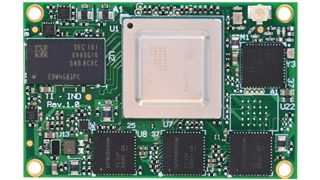 Figure 1 SolidRun's AM64x SoM Featuring
AM6442. (Image Courtesy of SolidRun Ltd.)
Figure 1 SolidRun's AM64x SoM Featuring
AM6442. (Image Courtesy of SolidRun Ltd.)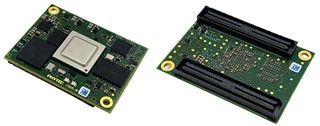 Figure 2 Phytec's phyCORE-AM64x PCB
Featuring AM6442: Top (Left); and Bottom (Right). (Image Courtesy of
PHYTEC)
Figure 2 Phytec's phyCORE-AM64x PCB
Featuring AM6442: Top (Left); and Bottom (Right). (Image Courtesy of
PHYTEC)- A computer-on-module (CoM) is indistinguishable from an SoM and most people use the acronyms SoM and CoM interchangeably. Whether you call it a SoM or a CoM, the key word here is "module," which means that something else – specifically the carrier board – must be combined with the PCB to make it useful in a commercial product.
- A carrier board (CB) or
baseboard is a PCB designed to mate electrically and mechanically
with a module (SoM or CoM) that contains all of the peripheral connectors for
using that module in an application. A system that requires display may have a
High-Definition Multimedia Interface connector on the CB, while a product that
needs Ethernet may have an RJ45 connector. Because the module is
application-agnostic, it is possible to customize the CB so that it only uses
the connectors needed in the commercial product and will thus fit within the
dimensions of a specific enclosure. A CB on its own will have an empty area near
the center where the module will be placed on the connector(s), as shown in
Figure 3.
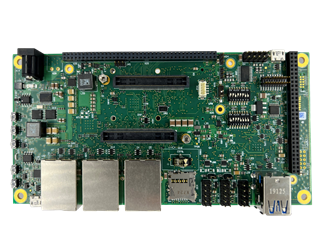 Figure 3 Phytec's
phyBOARD-AM64x Carrier Board (CB) PCB for the phyCORE-AM64x SoM. (Image
Courtesy of PHYTEC)
Figure 3 Phytec's
phyBOARD-AM64x Carrier Board (CB) PCB for the phyCORE-AM64x SoM. (Image
Courtesy of PHYTEC) - A development kit (DevKit or
DVK for short) combines an SoM and a CB in an attempt to maximize the
number of features that are theoretically possible with a module. Designers use
development kits to develop software or evaluate systems before designing a
custom CB for a specific application. The development kit's CB sometimes uses
multiplexers to show two features that would not normally be used
simultaneously. A development kit may include accessories such as LCD screens
and power supplies. The development kit is the result of mounting the SoM on the
generic CB, as shown in Figure 4.
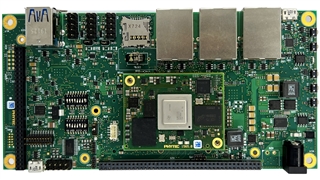 Figure 4 Phytec's
phyBOARD-AM64x-Electra Development Kit (SoM + CB). (Image Courtesy of
PHYTEC)
Figure 4 Phytec's
phyBOARD-AM64x-Electra Development Kit (SoM + CB). (Image Courtesy of
PHYTEC) - A single-board computer
(SBC) is an embedded computing product on a single PCB that contains the
processor, supporting ICs and peripheral connectors required for the system to
be functional. Although it may include connected accessories such as
add-in-cards or ribbon cables connected to camera modules, the SBC does not
require additional PCBs to operate. It is common to refer to an SoM and CB
system as an SBC, as in Figure 5; however, the BeagleBone Black (BEAGL-BONE-BLACK) and PocketBeagle are examples of a literal interpretation of an SBC.
 Figure 5 SolidRun's AM64x
HummingBoard-T SBC (SoM + CB) (Image Courtesy of SolidRun Ltd.)
Figure 5 SolidRun's AM64x
HummingBoard-T SBC (SoM + CB) (Image Courtesy of SolidRun Ltd.) - A system-in-package (SiP) has more than one IC (bare die or package) populated on the same substrate or PCB, which is then packaged in an enclosure for sale as a single product. Similar to an SoM or CoM, an SiP is a module; however, it is typically more densely populated and may be application-focused. A good example of an SiP is the OSD335x-SM from Octavo Systems. SiPs are more complex than a multichip module, and they differ from system-on-chips (SoCs) in that SoCs integrate multiple components on a single die. Most modern processors are actually SoCs.
- An application kit is a SoM + CB or SBC packaged in an enclosure and sold as an application-specific product. Application kits operate independently or are integrated into a larger network of devices using wired or wireless communication protocols. It is common for an application kit enclosure to have mounting holes for easy installation, as shown in Figure 6.
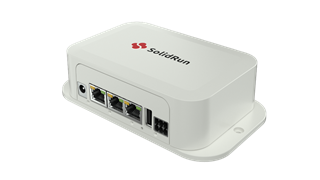 Figure 6 SolidRun's AM64x HummingBoard
SBC with Enclosure (Application Kit). (Image Courtesy of SolidRun Ltd.)
Figure 6 SolidRun's AM64x HummingBoard
SBC with Enclosure (Application Kit). (Image Courtesy of SolidRun Ltd.)As you can see, an SoM is a tiny, low-cost and flexible embedded computer on a PCB. An SoM is one of the fastest ways to leverage existing hardware and go to market with a product specific to nearly any application. The processor variants (speed grade, temperature rating) and memory sizes (512 MB, 1 GB) are usually customizable, in addition to the ability to design the custom carrier board to fit in the enclosure. The SoMs in this article are production-ready modules suited for building automation gateways, industrial automation gateways and much more.
Additional Resources
- Watch the December 7 installment of TI's Process This Webinar series, co-hosted by TI and SolidRun.
- Check out the AM64x SoM and Hummingboard SBC from SolidRun and phyCORE-AM64x SoM from Phytec.